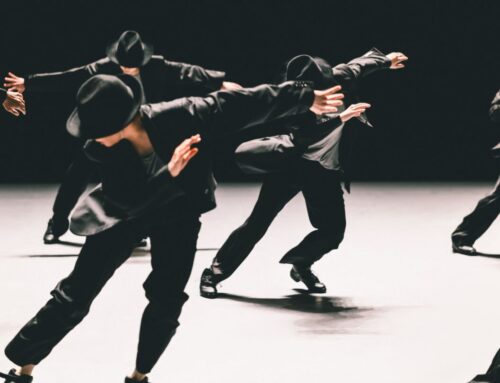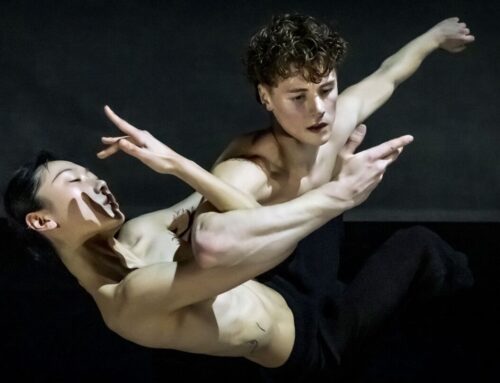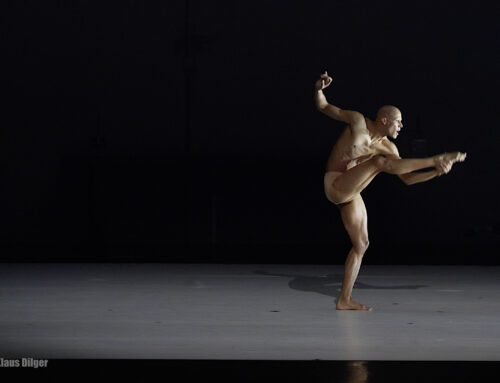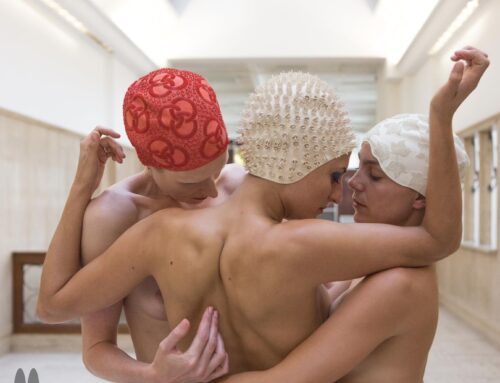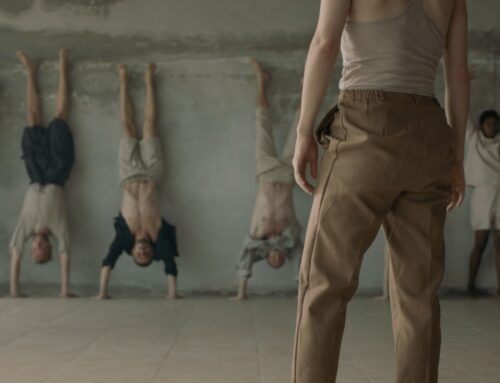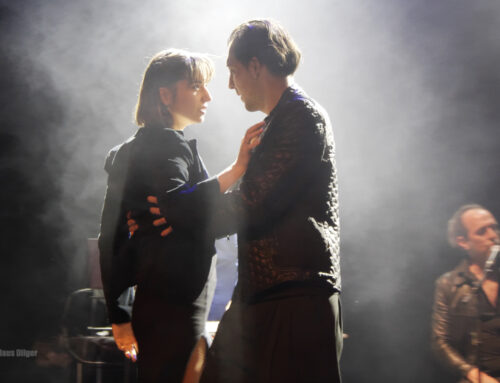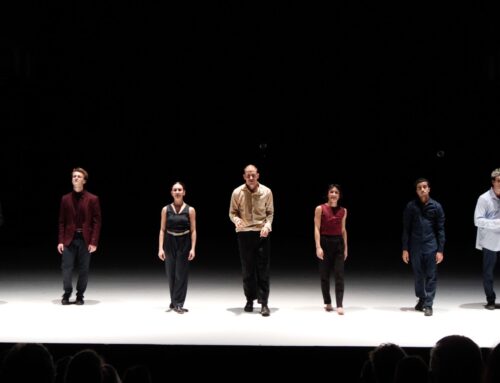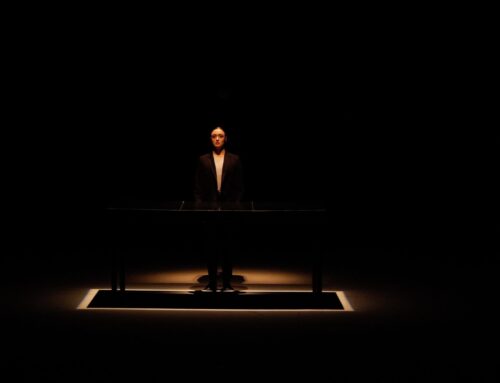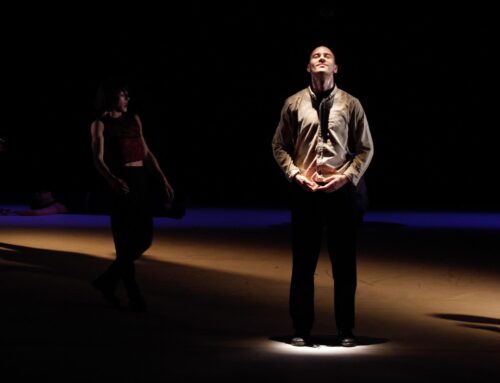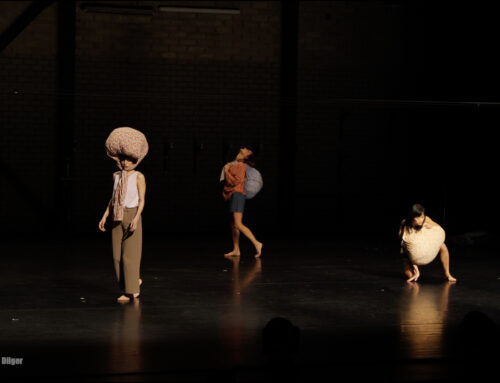‚Schrittmacher‘ in Heerlen: Guest Performance „to a simple, rock ’n‘ roll … song.“by the Michael Clark Company from Great Britain
nightreview by Nicole Strecker
translated by Karoline Strys
This is supposed to be the Bad-Ballet-Boy? Post-Punk of Danse d’école? What happens on the stage of choreographer Michael Clark seems rather like a ‘Playmobil’-Setting (themed world: outer space) of a compulsive neurotic fanatic of orderliness. Each movement a pose. Each step a placement in space, accurate and regulated. At no moment do the dancers come into flow, they never let themselves – beware! – fall into a movement. With serious faces, the men’s militarily parted hair, the women’s tight buns and, of course, the limbs extended to the maximum, they are exercising Clark’s incredibly richly loaded building kit. Holy posture, pious form – and yet… yes: really odd.
Beginning of the 1980s Michael Clark, born in Aberdeen, Scotland, is breaking out of the ballet world. Till then as a pupil of London’s Royal Ballet School and dancer at Ballet Rambert he was considered to be an exceptional talent. A ballet prince, maybe even a new Nurejew? Not in the least. Clark is founding his own company, is dancing to the music of the Sex Pistols, Iggy Pop, T. Rex or The Wire with bare bum and dildos. At that time in Germany William Forsythe is dismantling the ballet vocabulary while on the island Michael Clark shakes up the classic with American Postmodern Dance like the one of Merce Cunningham alongside British Punk and Glam Rock. In the movie “Prospero’s Books”, directed by Peter Greenaway, Clark is fondling his privates as baldheaded beast Caliban while spreading very elegantly the very beautiful long ballerina legs – a highlight of the eccentric film orgy. Then comes the fall. Drugs, depression, retirement from the stage. Now, he is a living legend – and is today himself dedicating a tribute in three parts to some of his admired legends: dance mentors like Merce Cunningham, Yvonne Rainer and Frederick Ashton. Music icons like Erik Satie, John Cage, David Bowie.
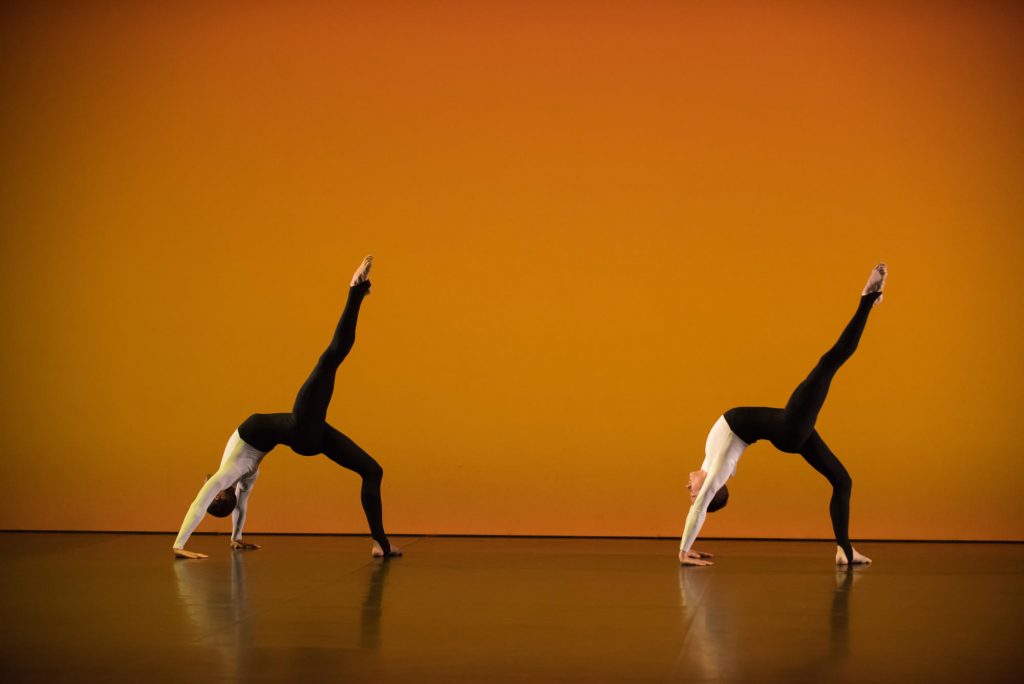
©Hugo Glendinning
„Act I: Satie Studs / Ogives Composite“, that is what Clark calls his first part to the music by Erik Satie. In skinny black-and-white catsuits like the keys of a piano and of course also a bit like Merce Cunninghams “Beach Birds” – that is how the dancers are standing on stage, neatly in a row. Already with the first measures Clark is letting them balance endlessly on one leg and perform a kind of ballet yoga that exposes every shaking, every trembling knee, every crease in the line.
How cruel towards the dancers. And yet the threat of wobbling is touching: How hard it is to be a dancer, how vulnerable is such a human being on stage and also: how strenuous is Michael Clark’s statuary complex style. Turns where the head is pointing towards the wrong direction. Split leaps with cotton-soft landings. Sideways tilted torsos, anyway always contrapuntally organized bodies. A push-up on the forearms where the legs are being held straight into the air for seconds by two dancers – like two synchronized divers in frozen synchronous flight. Fantastic, how Clark is rearranging here the material of Postmodern Dance anew and is also dramatizing it when later the pianist of the music recording is hitting the keys in furious despair and also every Developpé becomes a drama of existence.
To-a-simple-Rock-n-Roll-Song-Bowie-Hommage-Michael-Clark-Company–Foto-Anja-Beutler
When you admire the choreographic genius adequately in ‘Act I’, Clark is further pushing his perfectly dancing training horses on stage accompanied by Patti Smith’s “Land” from the album “Horses” and in front of the tremendous lighting whirls of the dance film maker and major Cunningham collaborator Charles Atlas. Atlas designs psychedelic patterns in black-and-white out of swirling numbers, indeed a whole universe of mathematical proportions which remind of Pythagoras’s harmony of the spheres as well as of our digital parallel universe of nowadays, created out of a simple binary code, so also zero. The number zero Atlas is always extending prominently to a gigantic oval – a black sun that is rushing towards us, a hole and a nothing that rules our world.
A great light installation, thereto Patti Smith’s poetic-harsh Rock and Michael Clark’s so consequently formalized and bizarrely drilled sex appeal of hips being pushed forward – alone for this part you have to see this piece that was created in 2016 and that already had guest performances in Germany in Hamburg and Berlin and is now opening the part of the festival “Schrittmacher” that takes place in Heerlen, Netherlands. In this second part two concrete images evolve in the dance: a gesture like the one of a throat slitting, implied homosexual sex,- a man is stroking through his hair as once the “Thin White Duke” David Bowie. This is probably an anticipation of the last part of the evening: “Act III: my mother, my dog and CLOWNS!“, with the music of Bowie.
The dancers in astronaut-silver leotards dedicate a defiant requiem to the pop idol who died in 2017. A woman dressed in black appears several times, strides as veiled grave sculpture diagonally over the stage. Clark starts with the song “Blackstar” from Bowie’s last Album that was released shortly before his surprising death – the quavering swan song of the eternally celestial space travelers. And in the end the piano turns up in such a way in the song “Aladdin Sane” as if it was the jazzy revenant of Erik Satie.
So that’s how it goes. That is how you get from the French, ironic simplicity of Satie to British Rock and Glam Rock. Michael Clark’s “to a simple rock’n‘ roll… song.“ is retrospective ballet-utopia. Exhilarating dance of mourning. Abstractly-controlled desire. A piece full of contradictions and not quite of this world. Or, to say it with the favorite word of Star-Trek-Longear Mr Spock: Fascinating.

